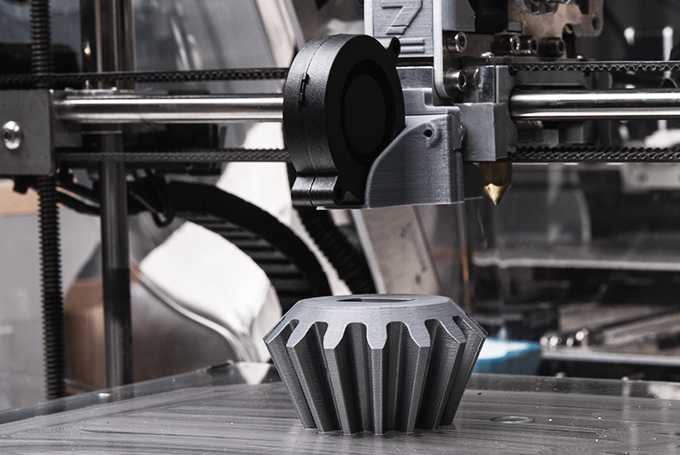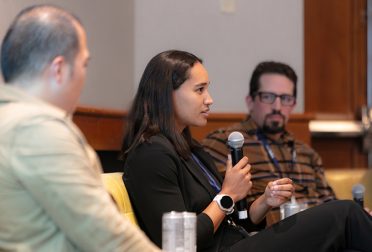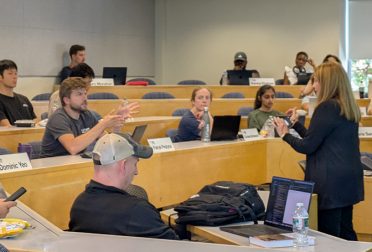System Design and Management students spend the spring semester applying the systems principles and tools they’ve learned in the classroom on real-world problems. These challenges are presented by learning partners, ranging from internationally recognized companies to startups to nonprofits and NGOs. Partners ask students to tackle issues they’re facing in the present day, such as how to bring new technology to market, improving an existing technology, or revolutionizing a system by transitioning to clean energy. In the spring of 2023, MIT’s own Center for Additive and Digital Advanced Production Technologies came to SDM with this question: could a student team create a roadmap for teaching the skills necessary to work in additive technologies, like 3D printing, that could be used to guide national policy?
The Center for Additive and Digital Advanced Production Technologies (APT) is headquartered at MIT and directed by Professor A. John Hart of the Mechanical Engineering department. APT is an industry consortium that works with members across the span of additive technologies and sponsors research conferences, holds events, and drives the adoption of new technologies through workshops and workforce education. In response to efforts from the federal and state governments to prepare for the future of manufacturing and grow U.S. manufacturing, MIT and APT hoped to design a standardized system to educate the current and future workforce in additive manufacturing.
This concept seemed well-suited to the SDM spring projects, said Haden Quinlan, APT’s program manager. A small project that was still in the early stages and ready for ideation worked well with the structure of SDM’s objectives for the spring term, which emphasize that the projects are primarily for the education of students rather than to provide a solution that’s ready for immediate implementation. The caliber of SDM students was also appealing. “You have professionals who have spent up to twenty years in industry before they came to SDM, and so the level of professionalism of the students is much higher,” Haden said. “That makes a big difference in how they run the project, how they communicate, and how they plan milestones and work as a team.”
The team of students working on the APT project included Warren Anderson, Don Duval, Hope Klukovich, and Rhea Thomas. Between them, the team members have a combined 68 years of experience. Additionally, Hope has taught at the university level, and Don’s work at NORCAT includes skilled labor training and development, so they had previous experience in the kinds of issues APT was asking them to tackle.
The team selected this project at a pitch session in January during MIT’s Independent Activities Period and continued their work into the spring. The spring term of SDM’s integrated core class is designed around the projects. Homework assignments focus on using the core principles of systems engineering, system architecture, and project management to explore the problem’s constraints and find potential solutions. “It was interesting to apply the principles from class to a more subjective exercise where there was no single right answer, and where multiple possible models might have been appropriate outcomes,” Warren said. They met every two weeks with Haden to discuss milestones and outcomes. Having access to their project partner on campus made it much easier to ask impromptu questions. It also offered the opportunity for a more free-flowing collaboration. “They appreciate the spirit of what we’re trying to do, and giving feedback and insight,” says Don. “I think that academic lens has been extremely beneficial to us.”
Over the last two days of classes, the student teams participated in a poster session and gave brief presentations summing up their findings. The APT team recommended a training series that could be delivered using AR or VR rather than hands-on, in-person programming. This would provide experiential training using the immersive nature of VR but also allow for more flexibility and adaptability. A training center could simply update the software rather than needing to replace machinery used for demonstrations and hands-on training. While this plan would face hurdles based on the willingness of participants to use VR technologies, the team still felt this offered the best combination of delivering the required training while being cost-effective and adaptable.
Haden felt that this recommendation was valuable and a viable path forward, and spoke highly of the experience. “As we write proposals and make arguments to funding sources that we have the right vision for the courses we want to teach and how to teach them, that will give us fairly grounded ammunition to make those arguments rather than our own best guesses. I’m excited about those prospects. And I think the work on its own could advance generally the understanding of the printing community,” he added.
If you are interested in participating in a future round of integrated core team projects, check out our informational page and contact Ignacio Vazquez, SDM Co-Director for Industry, at ignaciov@mit.edu.




